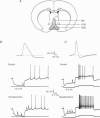Abstract
1. The physiological and pharmacological actions of noradrenaline (NA) on neurons of the medial septum and diagonal band of Broca (MSDB) were examined using extracellular, intracellular and whole-cell patch-clamp recordings in an in vitro rat brain slice preparation. 2. In current- and voltage-clamp recordings with KCl- or potassium gluconate-containing electrodes, bath-applied NA increased the number of tetrodoxin- and bicuculline-sensitive synaptic events in > 80% of cholinergic- and GABA-type neurons tested. The NA-induced synaptic activity originated from GABAergic neurons located within the MSDB itself, as a similar effect occurred in brain slices in which the MSDB had been surgically isolated from neighbouring structures. 3. In antidromic studies, NA dose-dependently increased firing in a subpopulation of septohippocampal neurons with fast conducting fibres (mean conduction velocity, 1.78 +/- 0.10 m s-1; presumably GABAergic). The NA excitation was mimicked by the alpha 1-agonist phenylephrine (PE) and blocked by the alpha 1-antagonists prazosin and WB-4101, suggesting the presence of alpha 1-receptors on septohippocampal GABAergic neurons. 4. Similarly, in whole-cell recordings in both cholinergic- and non-cholinergic-type MSDB neurons, prazosin blocked the effects of NA and PE mimicked the effects of NA by inducing IPSCs with a similar amplitude distribution. 5. Consistent with the above findings, GABA-type neurons that responded directly to NA and PE with a prazosin-sensitive inward current were found within the MSDB. 6. In conclusion, NA, via alpha 1-adrenoceptors, excites MSDB septohippocampal GABAergic neurons and influences both septal and septohippocampal circuitry.
Full text
PDF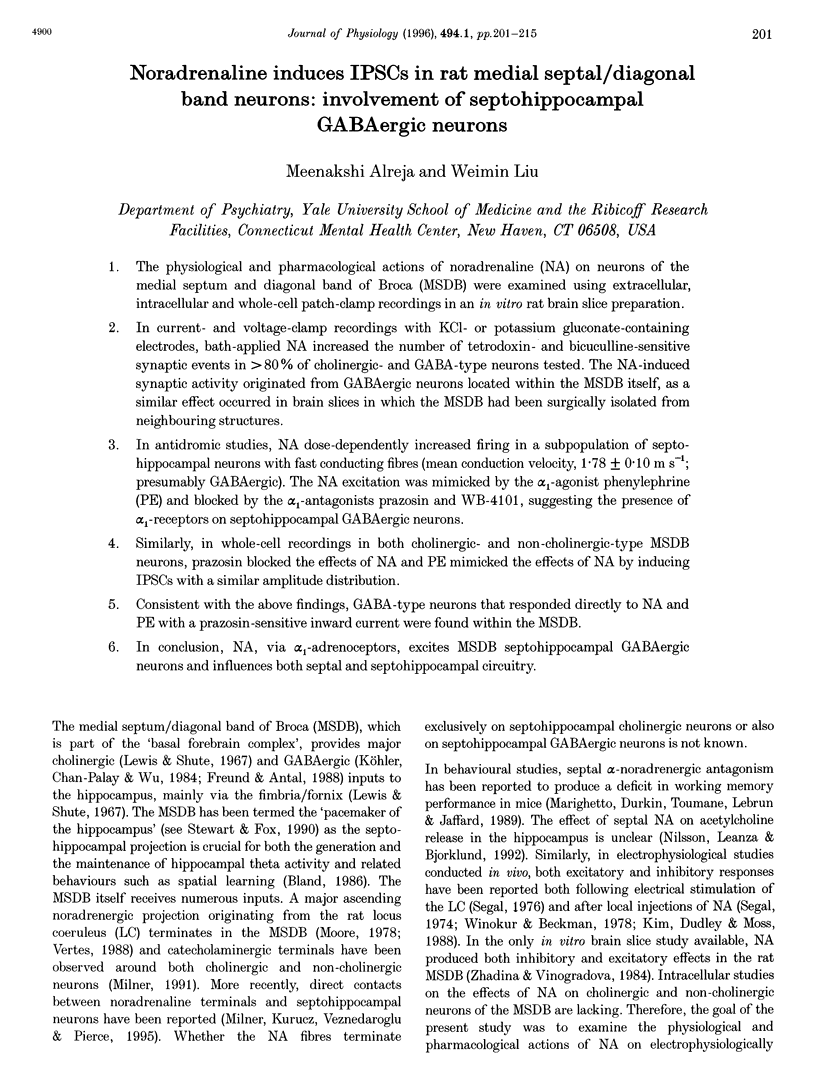
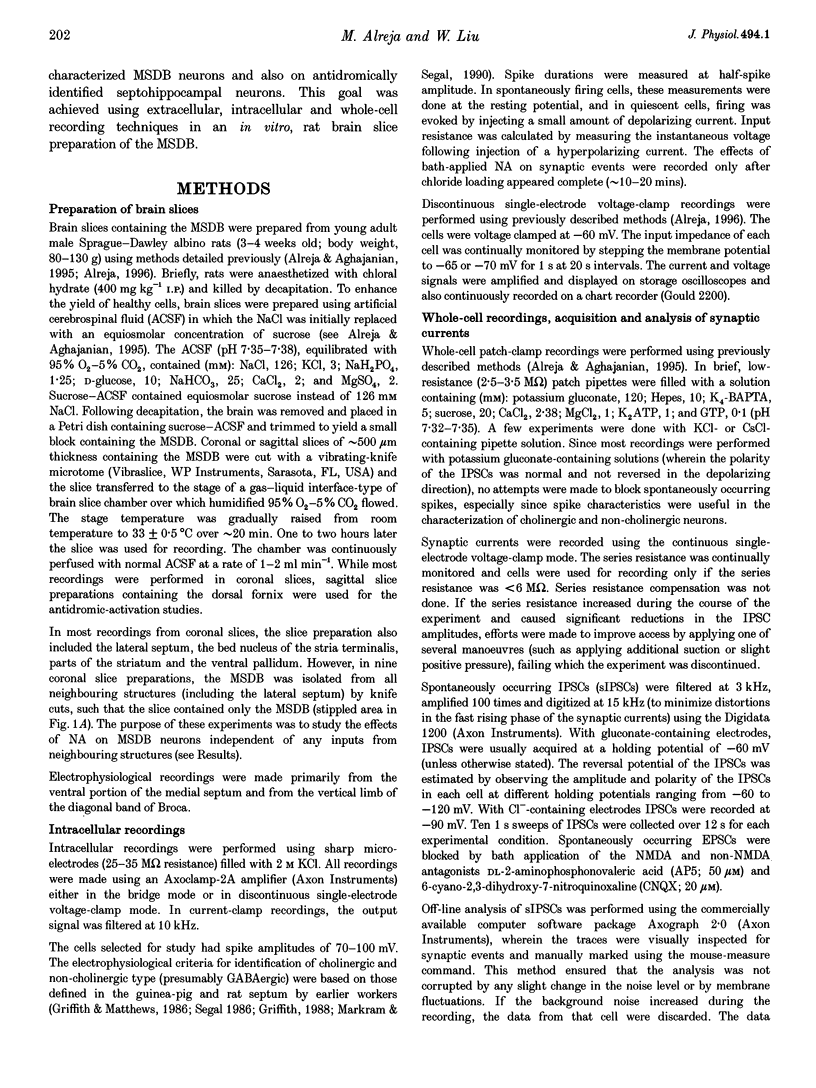
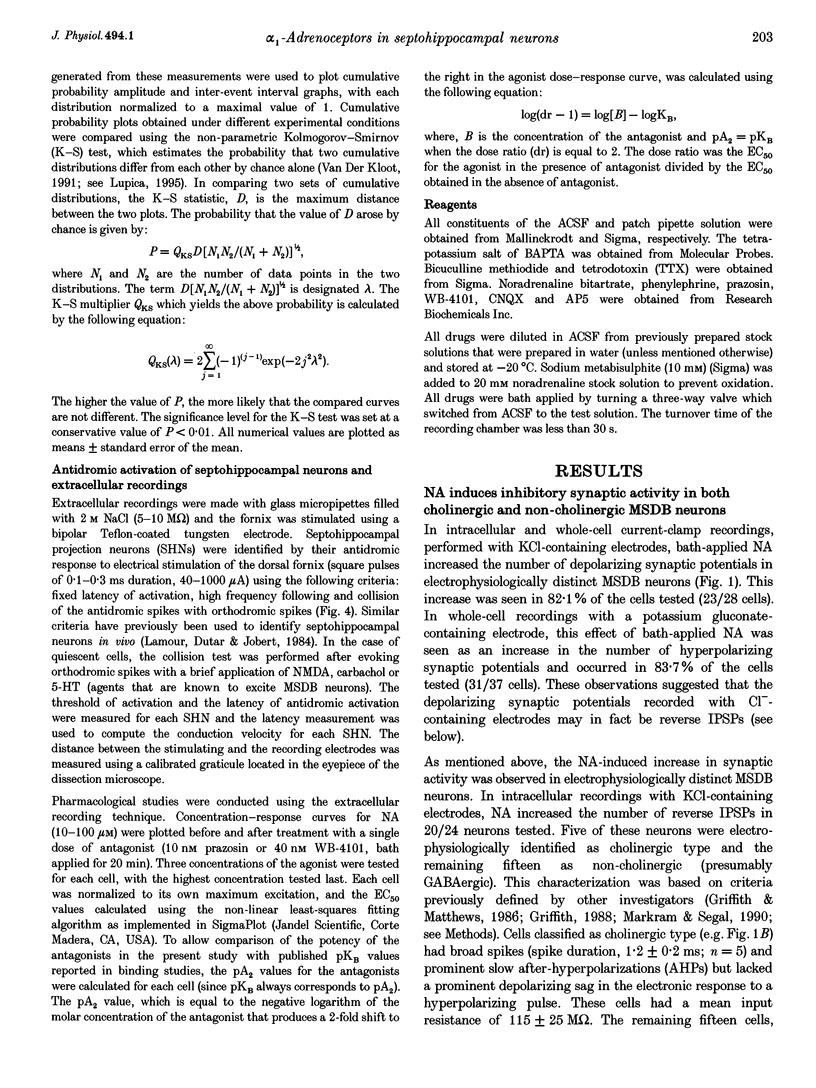
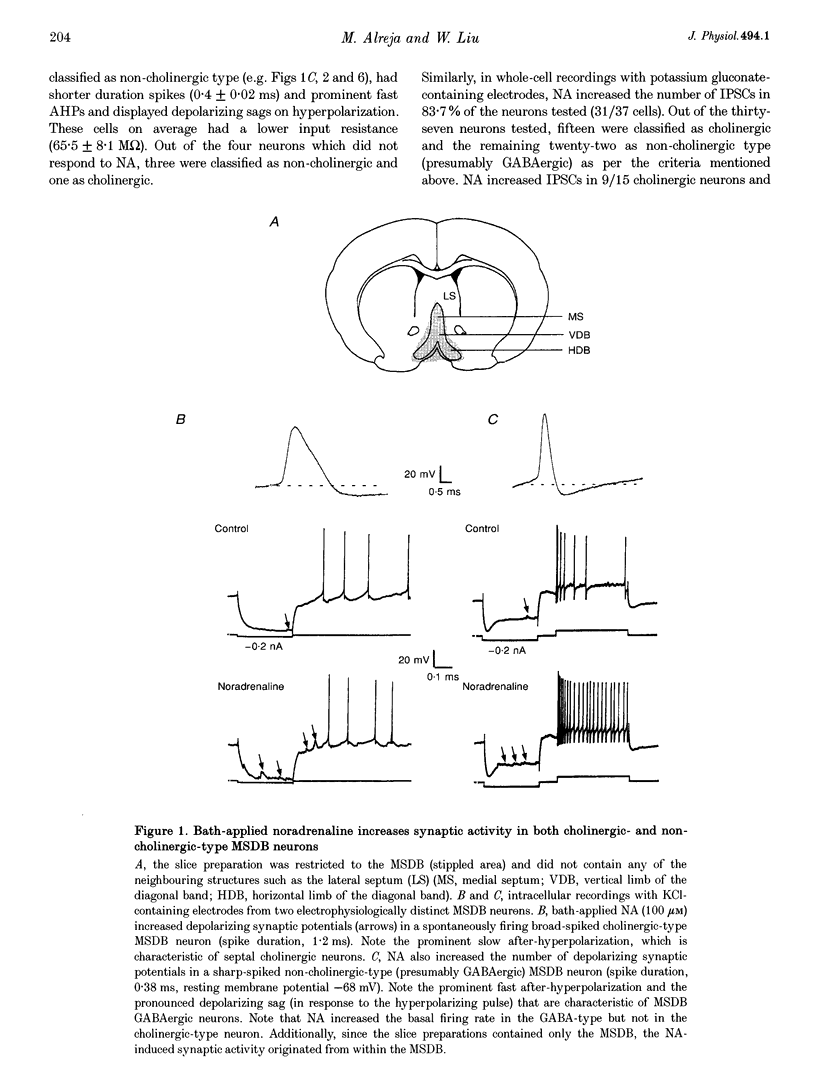
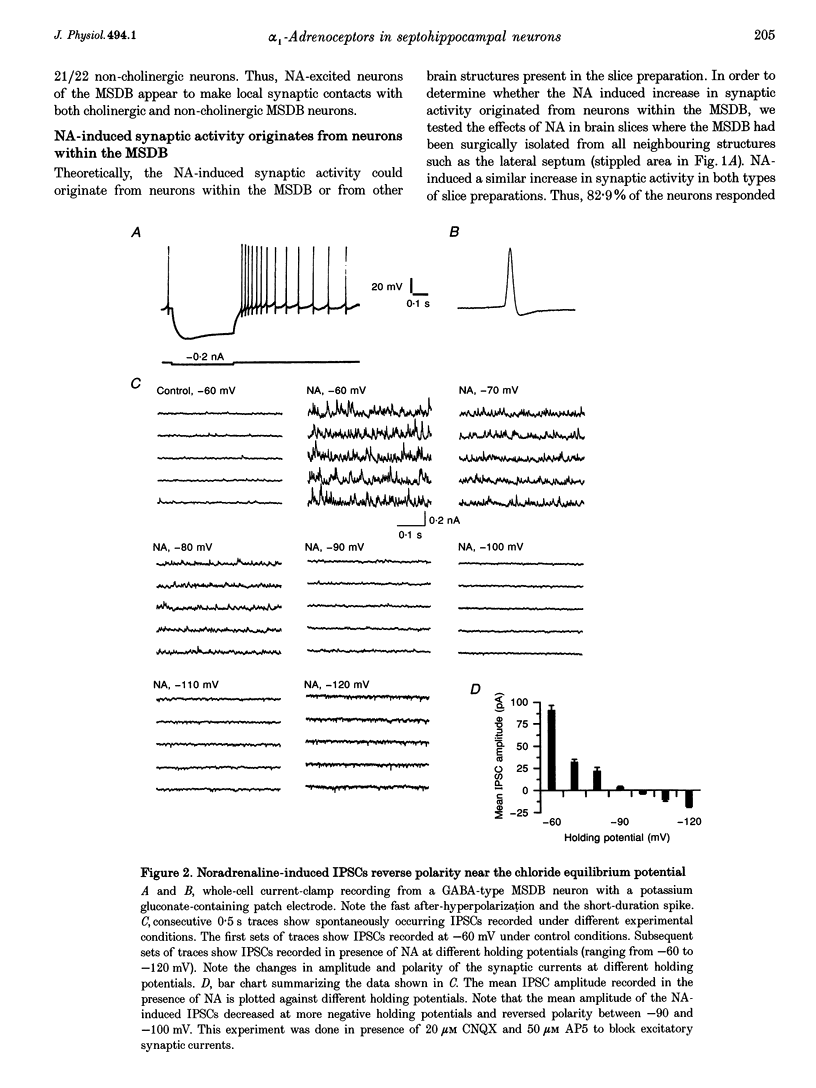
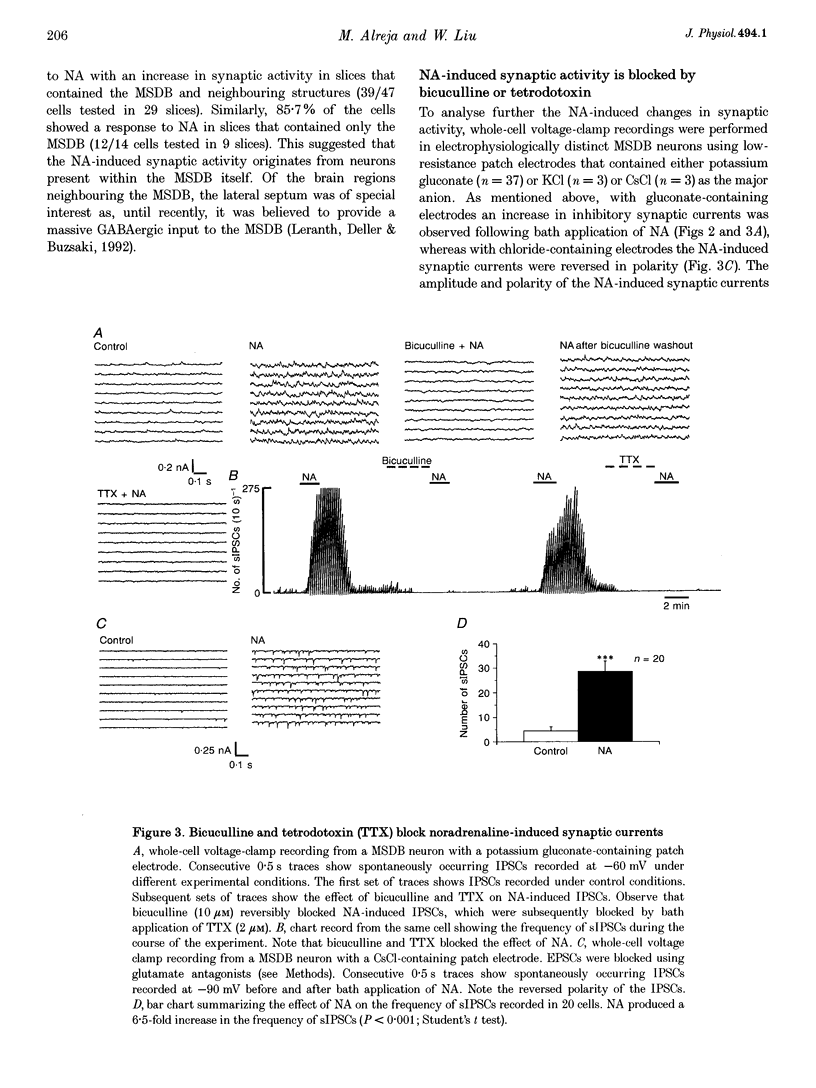
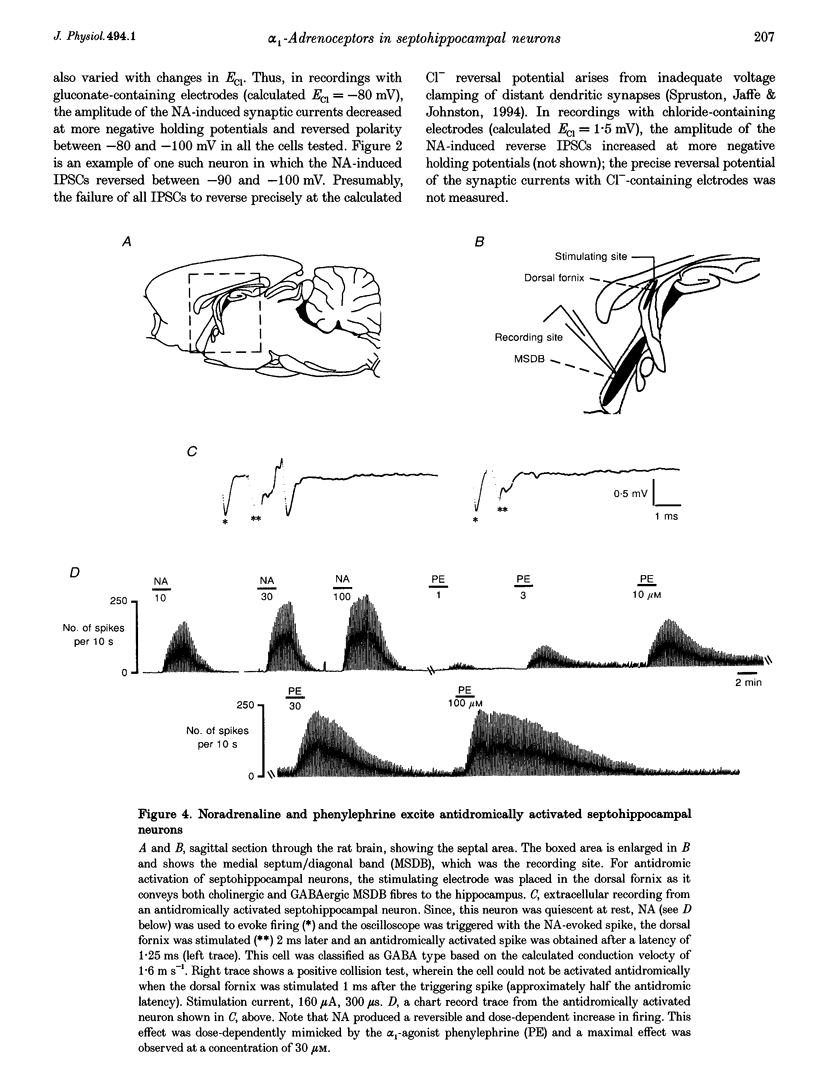
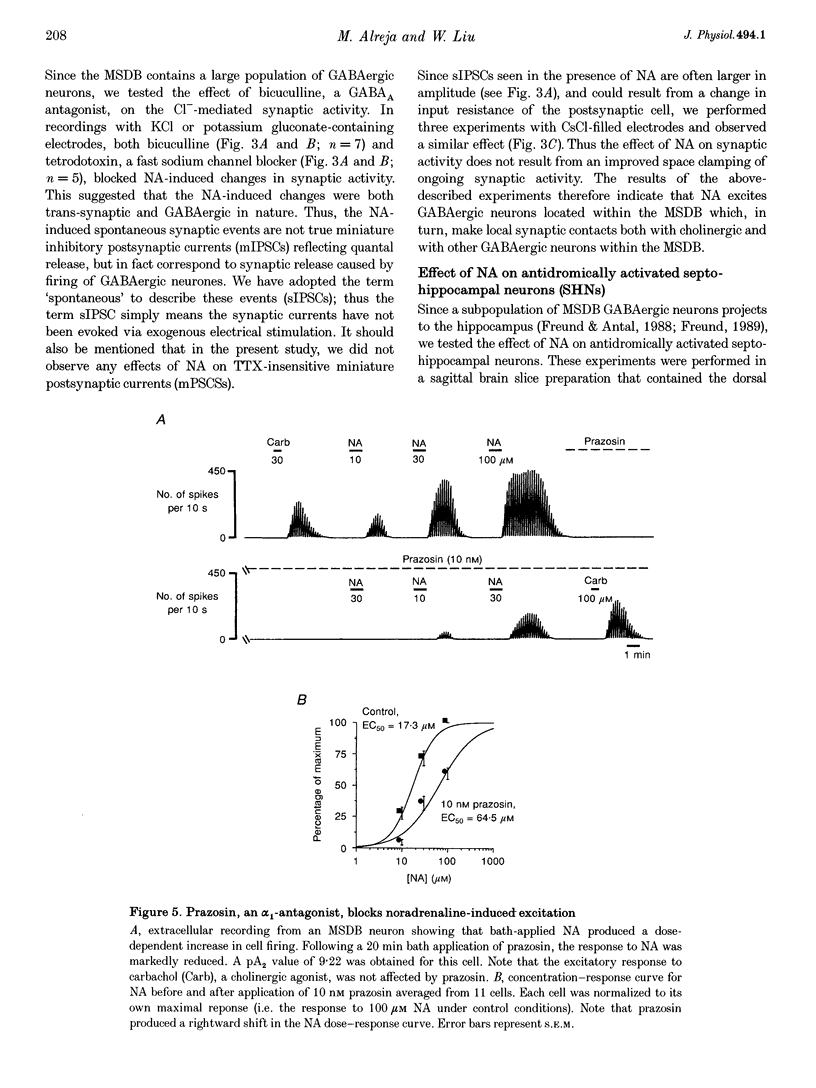
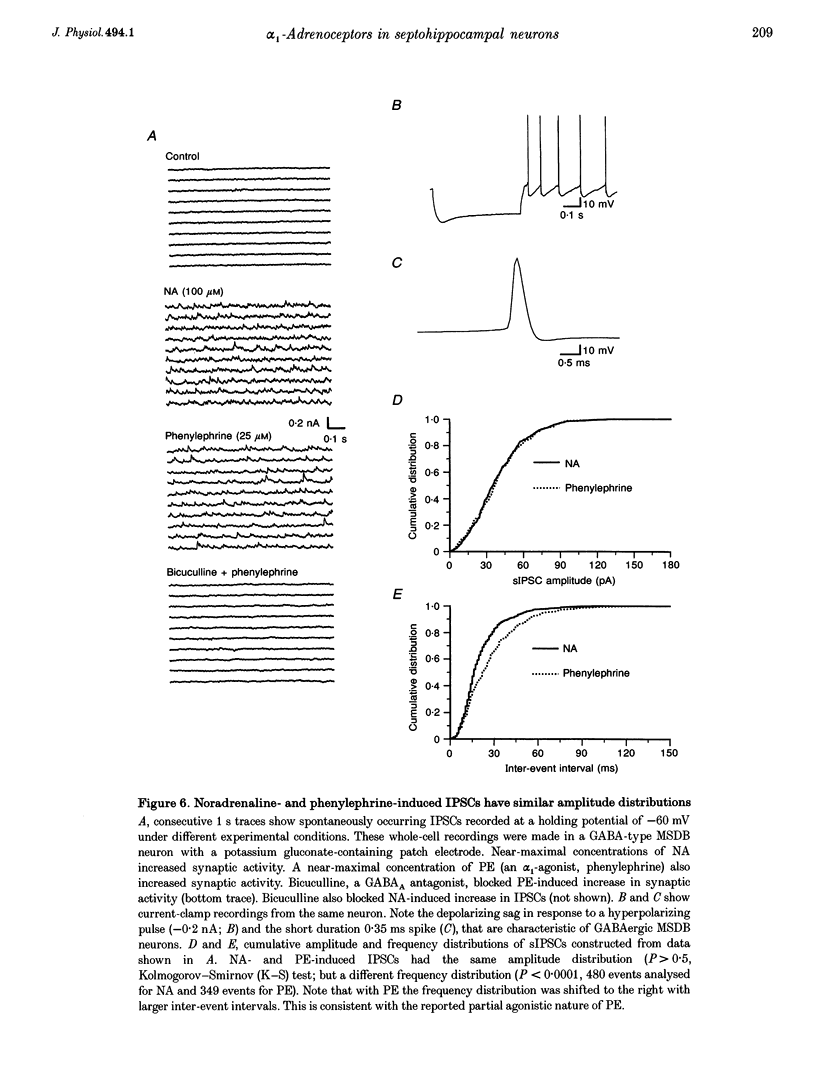
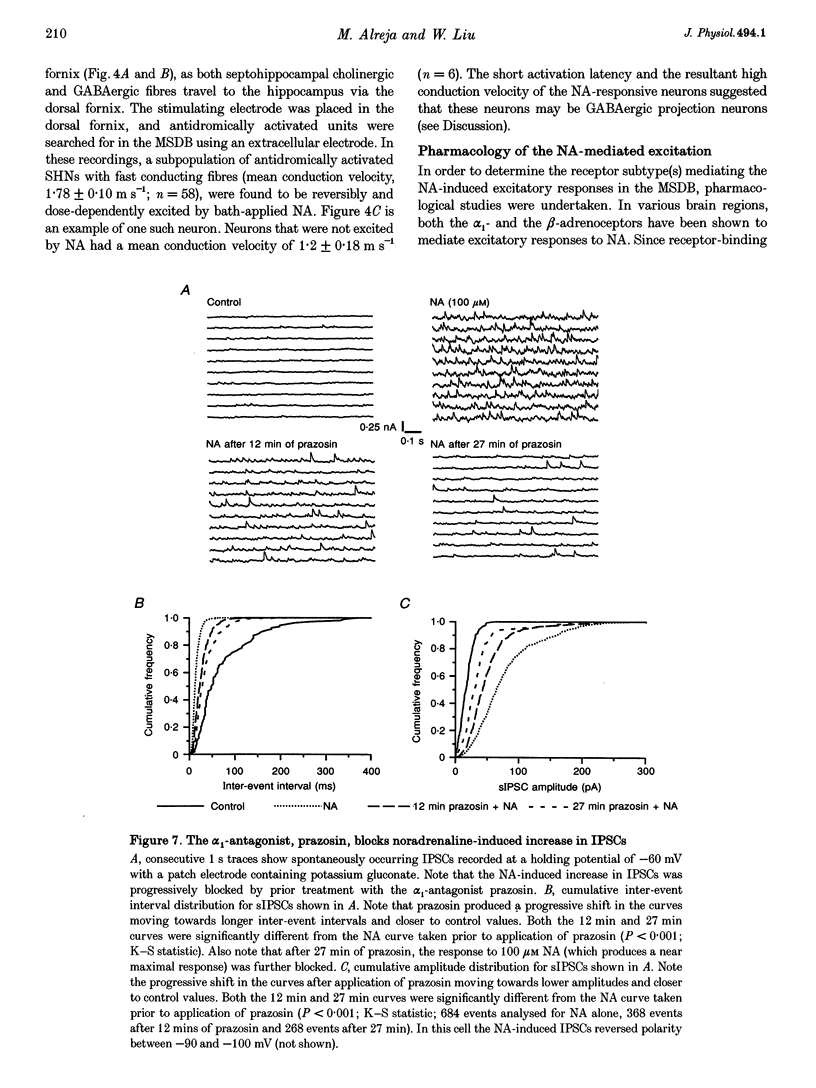
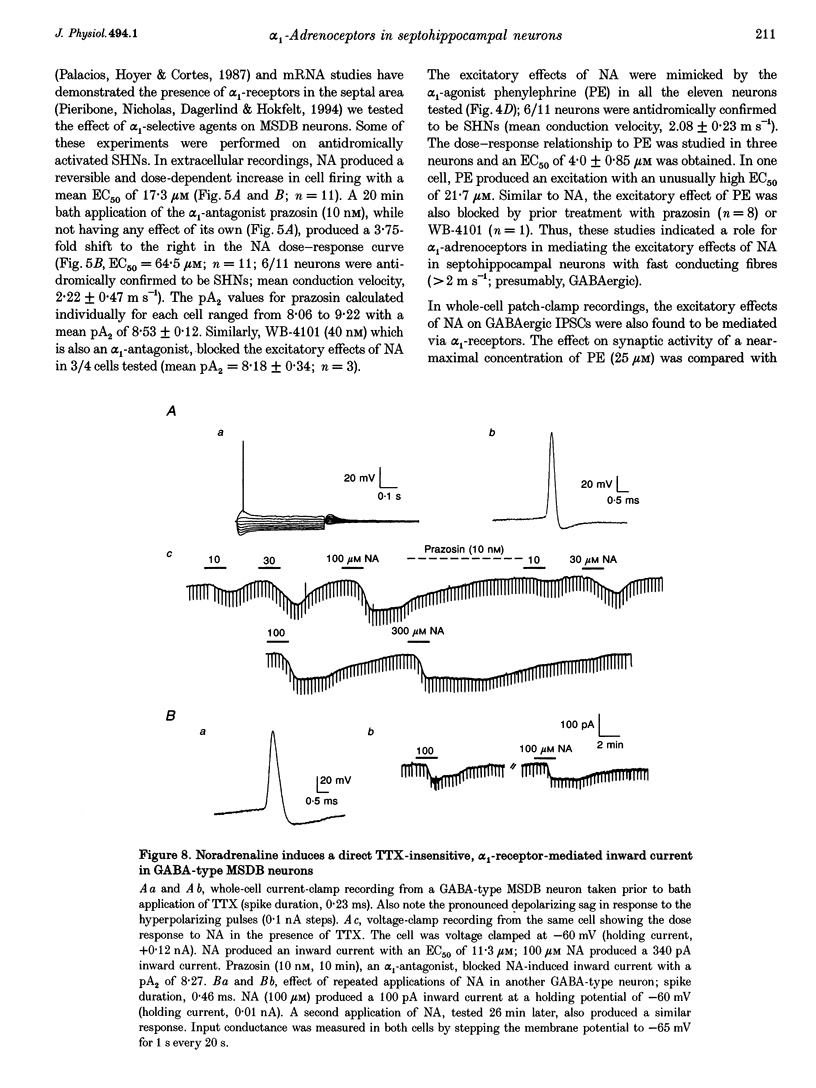
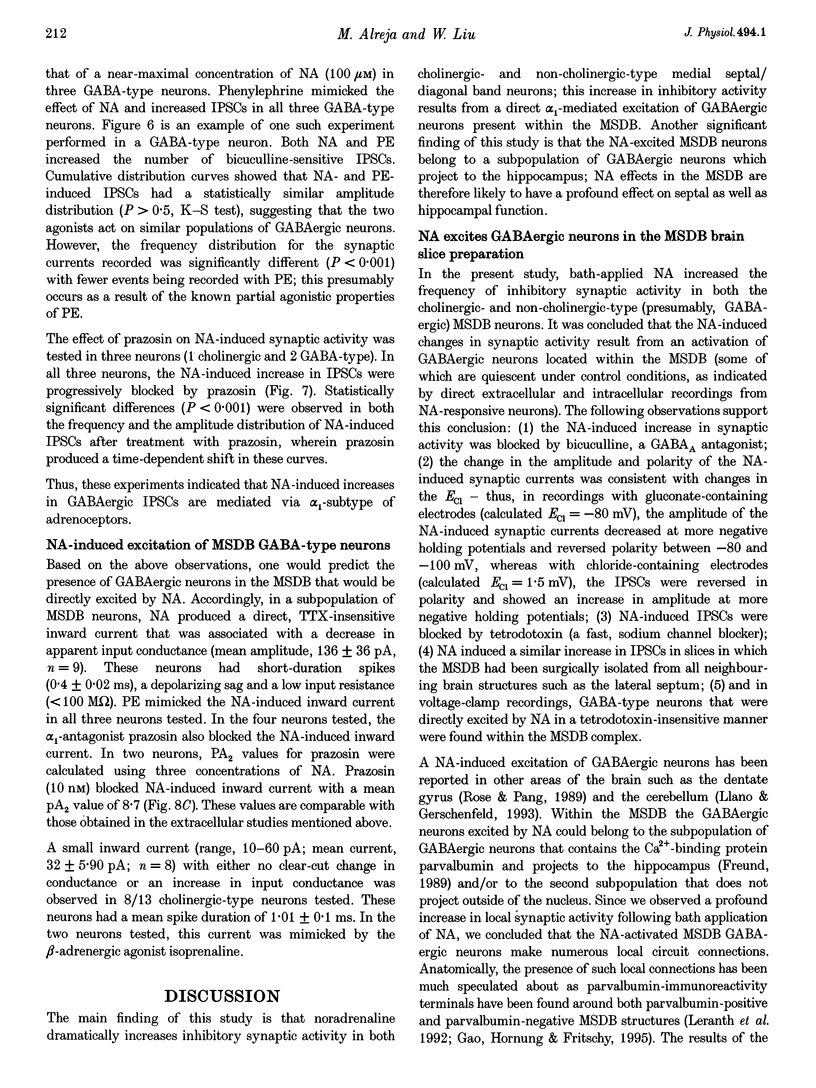
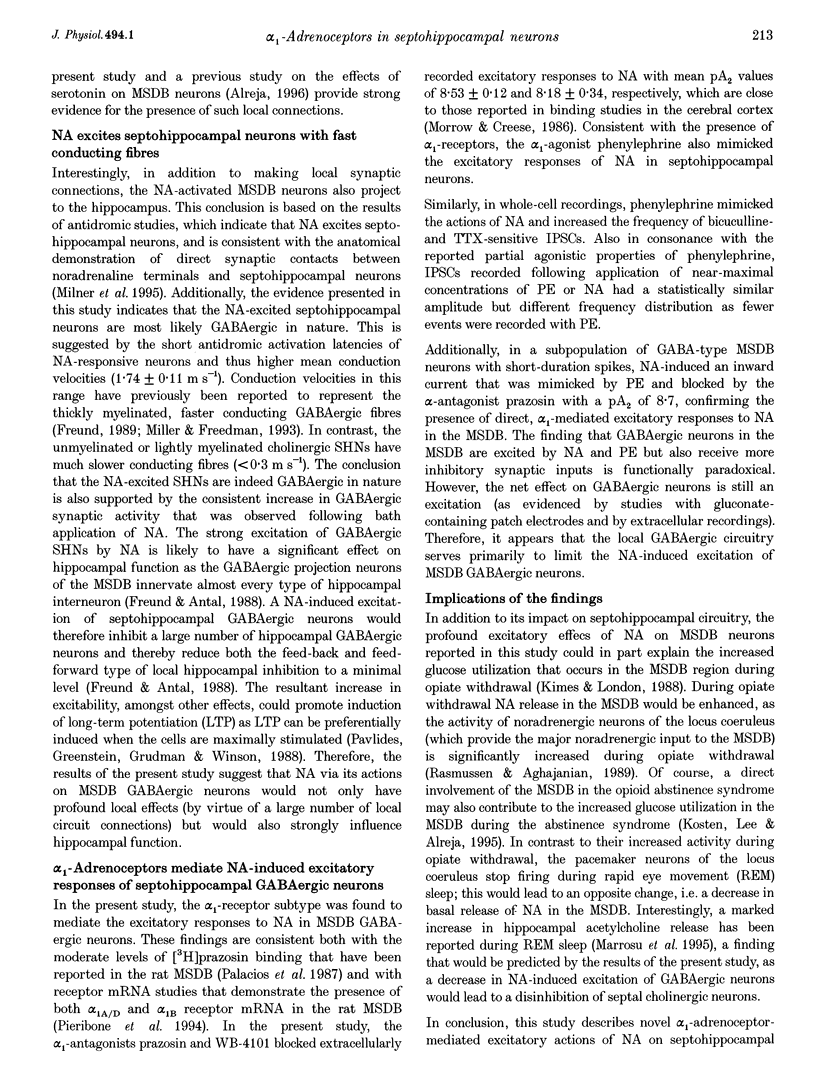
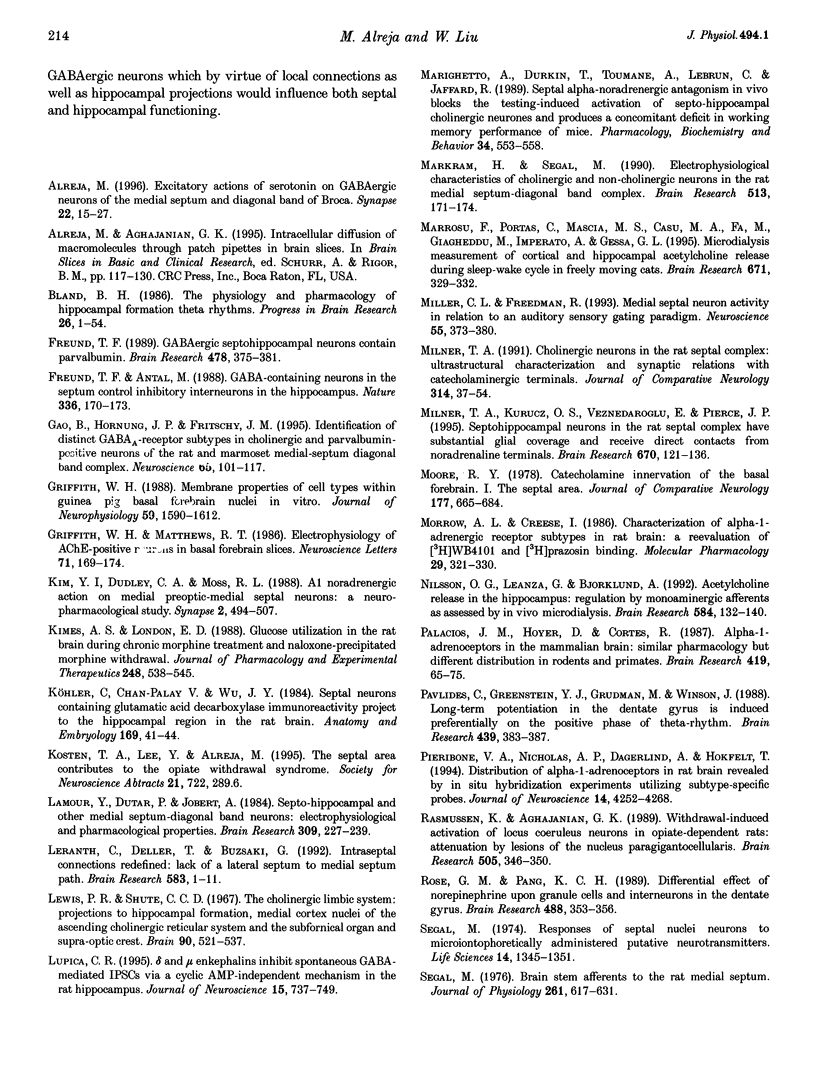
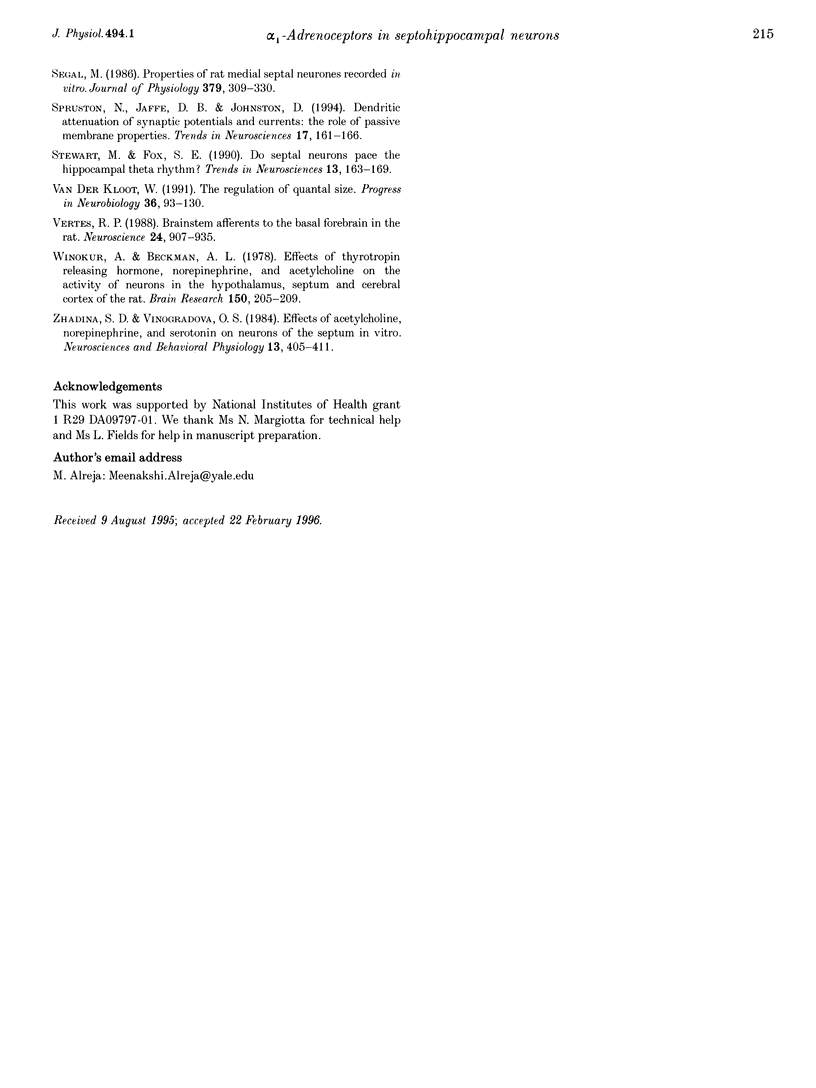
Images in this article
Selected References
These references are in PubMed. This may not be the complete list of references from this article.
- Alreja M. Excitatory actions of serotonin on GABAergic neurons of the medial septum and diagonal band of Broca. Synapse. 1996 Jan;22(1):15–27. doi: 10.1002/(SICI)1098-2396(199601)22:1<15::AID-SYN2>3.0.CO;2-L. [DOI] [PubMed] [Google Scholar]
- Bland B. H. The physiology and pharmacology of hippocampal formation theta rhythms. Prog Neurobiol. 1986;26(1):1–54. doi: 10.1016/0301-0082(86)90019-5. [DOI] [PubMed] [Google Scholar]
- Freund T. F., Antal M. GABA-containing neurons in the septum control inhibitory interneurons in the hippocampus. Nature. 1988 Nov 10;336(6195):170–173. doi: 10.1038/336170a0. [DOI] [PubMed] [Google Scholar]
- Freund T. F. GABAergic septohippocampal neurons contain parvalbumin. Brain Res. 1989 Jan 30;478(2):375–381. doi: 10.1016/0006-8993(89)91520-5. [DOI] [PubMed] [Google Scholar]
- Gao B., Hornung J. P., Fritschy J. M. Identification of distinct GABAA-receptor subtypes in cholinergic and parvalbumin-positive neurons of the rat and marmoset medial septum-diagonal band complex. Neuroscience. 1995 Mar;65(1):101–117. doi: 10.1016/0306-4522(94)00480-s. [DOI] [PubMed] [Google Scholar]
- Griffith W. H., Matthews R. T. Electrophysiology of AChE-positive neurons in basal forebrain slices. Neurosci Lett. 1986 Nov 11;71(2):169–174. doi: 10.1016/0304-3940(86)90553-7. [DOI] [PubMed] [Google Scholar]
- Griffith W. H. Membrane properties of cell types within guinea pig basal forebrain nuclei in vitro. J Neurophysiol. 1988 May;59(5):1590–1612. doi: 10.1152/jn.1988.59.5.1590. [DOI] [PubMed] [Google Scholar]
- Kim Y. I., Dudley C. A., Moss R. L. A1 noradrenergic action on medial preoptic-medial septal neurons: a neuropharmacological study. Synapse. 1988;2(5):494–507. doi: 10.1002/syn.890020505. [DOI] [PubMed] [Google Scholar]
- Kimes A. S., London E. D. Glucose utilization in the rat brain during chronic morphine treatment and naloxone-precipitated morphine withdrawal. J Pharmacol Exp Ther. 1989 Feb;248(2):538–545. [PubMed] [Google Scholar]
- Köhler C., Chan-Palay V., Wu J. Y. Septal neurons containing glutamic acid decarboxylase immunoreactivity project to the hippocampal region in the rat brain. Anat Embryol (Berl) 1984;169(1):41–44. doi: 10.1007/BF00300585. [DOI] [PubMed] [Google Scholar]
- Lamour Y., Dutar P., Jobert A. Septo-hippocampal and other medial septum-diagonal band neurons: electrophysiological and pharmacological properties. Brain Res. 1984 Sep 10;309(2):227–239. doi: 10.1016/0006-8993(84)90588-2. [DOI] [PubMed] [Google Scholar]
- Leranth C., Deller T., Buzsáki G. Intraseptal connections redefined: lack of a lateral septum to medial septum path. Brain Res. 1992 Jun 26;583(1-2):1–11. doi: 10.1016/s0006-8993(10)80004-6. [DOI] [PubMed] [Google Scholar]
- Lewis P. R., Shute C. C. The cholinergic limbic system: projections to hippocampal formation, medial cortex, nuclei of the ascending cholinergic reticular system, and the subfornical organ and supra-optic crest. Brain. 1967 Sep;90(3):521–540. doi: 10.1093/brain/90.3.521. [DOI] [PubMed] [Google Scholar]
- Lupica C. R. Delta and mu enkephalins inhibit spontaneous GABA-mediated IPSCs via a cyclic AMP-independent mechanism in the rat hippocampus. J Neurosci. 1995 Jan;15(1 Pt 2):737–749. doi: 10.1523/JNEUROSCI.15-01-00737.1995. [DOI] [PMC free article] [PubMed] [Google Scholar]
- Marighetto A., Durkin T., Toumane A., Lebrun C., Jaffard R. Septal alpha-noradrenergic antagonism in vivo blocks the testing-induced activation of septo-hippocampal cholinergic neurones and produces a concomitant deficit in working memory performance of mice. Pharmacol Biochem Behav. 1989 Nov;34(3):553–558. doi: 10.1016/0091-3057(89)90557-1. [DOI] [PubMed] [Google Scholar]
- Markram H., Segal M. Electrophysiological characteristics of cholinergic and non-cholinergic neurons in the rat medial septum-diagonal band complex. Brain Res. 1990 Apr 9;513(1):171–174. doi: 10.1016/0006-8993(90)91106-q. [DOI] [PubMed] [Google Scholar]
- Marrosu F., Portas C., Mascia M. S., Casu M. A., Fà M., Giagheddu M., Imperato A., Gessa G. L. Microdialysis measurement of cortical and hippocampal acetylcholine release during sleep-wake cycle in freely moving cats. Brain Res. 1995 Feb 13;671(2):329–332. doi: 10.1016/0006-8993(94)01399-3. [DOI] [PubMed] [Google Scholar]
- Miller C. L., Freedman R. Medial septal neuron activity in relation to an auditory sensory gating paradigm. Neuroscience. 1993 Jul;55(2):373–380. doi: 10.1016/0306-4522(93)90506-b. [DOI] [PubMed] [Google Scholar]
- Milner T. A. Cholinergic neurons in the rat septal complex: ultrastructural characterization and synaptic relations with catecholaminergic terminals. J Comp Neurol. 1991 Dec 1;314(1):37–54. doi: 10.1002/cne.903140105. [DOI] [PubMed] [Google Scholar]
- Milner T. A., Kurucz O. S., Veznedaroglu E., Pierce J. P. Septohippocampal neurons in the rat septal complex have substantial glial coverage and receive direct contacts from noradrenaline terminals. Brain Res. 1995 Jan 23;670(1):121–136. doi: 10.1016/0006-8993(94)01270-r. [DOI] [PubMed] [Google Scholar]
- Moore R. Y. Catecholamin innervation of the basal forebrain. I. The septal area. J Comp Neurol. 1978 Feb 15;177(4):665–684. doi: 10.1002/cne.901770408. [DOI] [PubMed] [Google Scholar]
- Morrow A. L., Creese I. Characterization of alpha 1-adrenergic receptor subtypes in rat brain: a reevaluation of [3H]WB4104 and [3H]prazosin binding. Mol Pharmacol. 1986 Apr;29(4):321–330. [PubMed] [Google Scholar]
- Nilsson O. G., Leanza G., Björklund A. Acetylcholine release in the hippocampus: regulation by monoaminergic afferents as assessed by in vivo microdialysis. Brain Res. 1992 Jul 3;584(1-2):132–140. doi: 10.1016/0006-8993(92)90886-e. [DOI] [PubMed] [Google Scholar]
- Palacios J. M., Hoyer D., Cortés R. alpha 1-Adrenoceptors in the mammalian brain: similar pharmacology but different distribution in rodents and primates. Brain Res. 1987 Sep 1;419(1-2):65–75. doi: 10.1016/0006-8993(87)90569-5. [DOI] [PubMed] [Google Scholar]
- Pavlides C., Greenstein Y. J., Grudman M., Winson J. Long-term potentiation in the dentate gyrus is induced preferentially on the positive phase of theta-rhythm. Brain Res. 1988 Jan 26;439(1-2):383–387. doi: 10.1016/0006-8993(88)91499-0. [DOI] [PubMed] [Google Scholar]
- Pieribone V. A., Nicholas A. P., Dagerlind A., Hökfelt T. Distribution of alpha 1 adrenoceptors in rat brain revealed by in situ hybridization experiments utilizing subtype-specific probes. J Neurosci. 1994 Jul;14(7):4252–4268. doi: 10.1523/JNEUROSCI.14-07-04252.1994. [DOI] [PMC free article] [PubMed] [Google Scholar]
- Rasmussen K., Aghajanian G. K. Withdrawal-induced activation of locus coeruleus neurons in opiate-dependent rats: attenuation by lesions of the nucleus paragigantocellularis. Brain Res. 1989 Dec 29;505(2):346–350. doi: 10.1016/0006-8993(89)91466-2. [DOI] [PubMed] [Google Scholar]
- Rose G. M., Pang K. C. Differential effect of norepinephrine upon granule cells and interneurons in the dentate gyrus. Brain Res. 1989 May 29;488(1-2):353–356. doi: 10.1016/0006-8993(89)90729-4. [DOI] [PubMed] [Google Scholar]
- Segal M. Brain stem afferents to the rat medial septum. J Physiol. 1976 Oct;261(3):617–631. doi: 10.1113/jphysiol.1976.sp011577. [DOI] [PMC free article] [PubMed] [Google Scholar]
- Segal M. Properties of rat medial septal neurones recorded in vitro. J Physiol. 1986 Oct;379:309–330. doi: 10.1113/jphysiol.1986.sp016255. [DOI] [PMC free article] [PubMed] [Google Scholar]
- Segal M. Responses of septal nuclei neurons to microiontophoretically administered putative neurotransmitters. Life Sci. 1974 Apr 1;14(7):1345–1351. doi: 10.1016/0024-3205(74)90443-3. [DOI] [PubMed] [Google Scholar]
- Spruston N., Jaffe D. B., Johnston D. Dendritic attenuation of synaptic potentials and currents: the role of passive membrane properties. Trends Neurosci. 1994 Apr;17(4):161–166. doi: 10.1016/0166-2236(94)90094-9. [DOI] [PubMed] [Google Scholar]
- Stewart M., Fox S. E. Do septal neurons pace the hippocampal theta rhythm? Trends Neurosci. 1990 May;13(5):163–168. doi: 10.1016/0166-2236(90)90040-h. [DOI] [PubMed] [Google Scholar]
- Van der Kloot W. The regulation of quantal size. Prog Neurobiol. 1991;36(2):93–130. doi: 10.1016/0301-0082(91)90019-w. [DOI] [PubMed] [Google Scholar]
- Vertes R. P. Brainstem afferents to the basal forebrain in the rat. Neuroscience. 1988 Mar;24(3):907–935. doi: 10.1016/0306-4522(88)90077-2. [DOI] [PubMed] [Google Scholar]
- Winokur A., Beckman A. L. Effects of thyrotropin releasing hormone, norepinephrine and acetylcholine on the activity of neurons in the hypothalamus, septum and cerebral cortex of the rat. Brain Res. 1978 Jul 7;150(1):205–209. doi: 10.1016/0006-8993(78)90668-6. [DOI] [PubMed] [Google Scholar]
- Zhadina S. D., Vinogradova O. S. Effects of acetylcholine, norepinephrine, and serotonin on neurons of the septum in vitro. Neurosci Behav Physiol. 1983 Nov-Dec;13(6):405–411. doi: 10.1007/BF01182682. [DOI] [PubMed] [Google Scholar]



